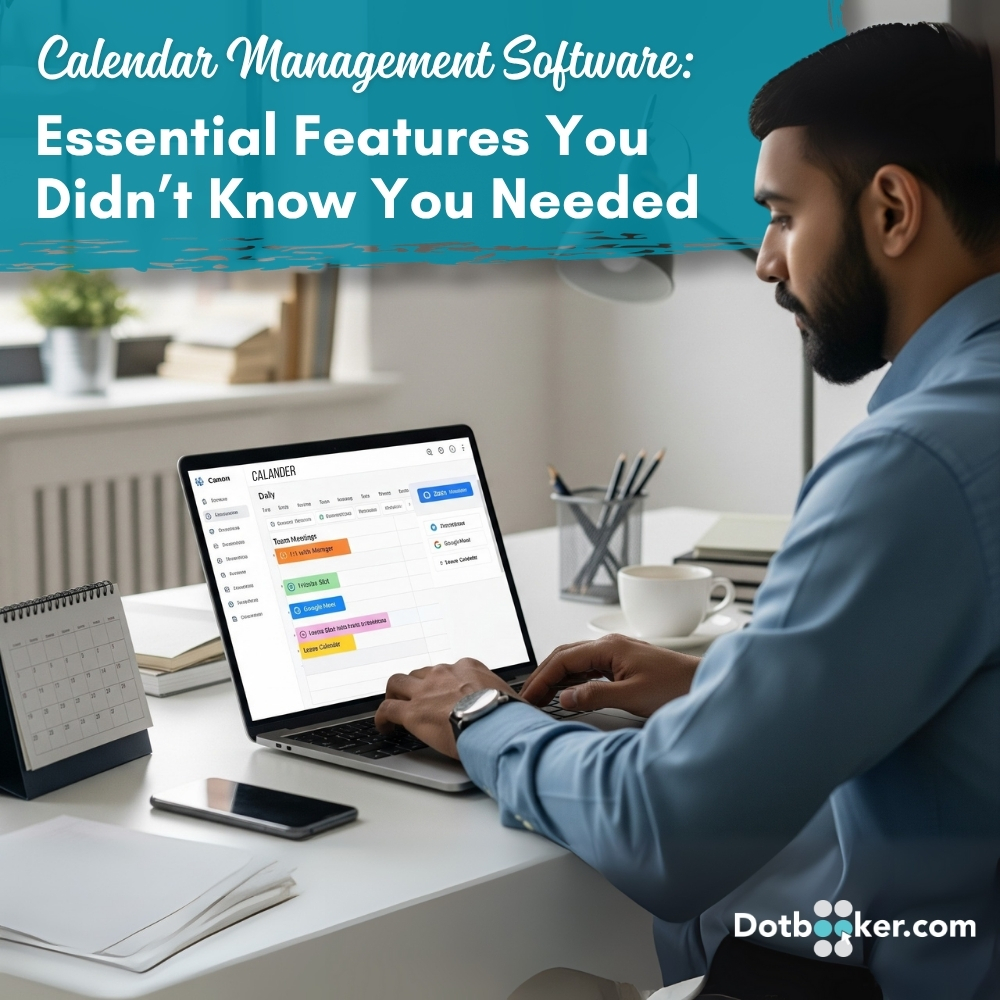
- By Dotbooker
- Aug 14, 2025
- 420
Calendar Management Software: Essential Features You Didn’t Know You Needed
Everyone thinks they know what a calendar is for—set a date, mark a time, maybe color-code a few blocks, and you’re done. Right? Not quite.
What if your calendar could do more than remind you of your next meeting? What if it could manage bookings, sync client preferences, prevent scheduling conflicts, and even boost revenue?
Welcome to the modern era of calendar management software—where the humble scheduler transforms into an intelligent system that silently powers your entire day-to-day operations.
Let’s dive into the essential features that many businesses overlook—yet can’t afford to ignore.
1. Intelligent Conflict Prevention and Auto-Suggestions
In busy environments like gyms, therapy clinics, or studios, double-booking is more common than you might think. A receptionist may schedule someone at 4 PM, unaware that a trainer is already booked at the same time. The result? Confusion, customer dissatisfaction, and sometimes, lost business.
Modern calendar booking tools are built to prevent this. Instead of just saying, "This time is taken," they go one step further by:
- Alerting staff of overlapping appointments
- Offering alternative time slots immediately
- Notifying you if a room, trainer, or piece of equipment is unavailable
For example, if your main massage room is already booked, the system may automatically suggest an alternative available room or propose a different time to the client.
This isn’t just about avoiding errors. It’s about running a smoother, smarter business where technology handles the back-and-forth—before the conflict even happens.

2. Real-Time Sync Across Multiple Devices and Locations
Picture this: A client books a yoga class on your website from their phone. At the same time, your front desk schedules a walk-in on the tablet. Meanwhile, your instructor checks the desktop in the break room to review the day’s lineup.
Without proper syncing, this can easily become a recipe for chaos.
However, with a powerful calendar management software, every change—regardless of who made it or where it originated—is updated instantly across all devices. That means your schedule stays accurate in real-time, whether it’s viewed from a phone, tablet, or computer.
It also solves the problem of multiple locations. Whether you have one studio or five, everything is kept in sync so everyone sees the same, up-to-date calendar. No miscommunication. No mistakes.
3. Integrated Staff and Resource Allocation
A successful booking isn’t just about finding an open time slot—it also requires the right person and the right space or equipment to be available.
Let’s say a client books a strength training session. The software should not only secure the time but also assign:
- The personal trainer qualified for that session
- The specific studio room or gym space available
- Any required equipment (like kettlebells or mats)
This removes the manual back-and-forth between departments. With smart automation, the system cross-checks staff availability and resource status, ensuring each booking is fully prepared from the get-go.
So instead of scrambling at the last minute, your team walks into every session ready to go—because your calendar has already taken care of the planning.
4. Automated Follow-Ups and Reminders That Go Beyond Text
A simple reminder message is no longer enough to keep clients engaged.
Top-tier calendar booking tools now take follow-ups to the next level. For example:
- A day before an appointment, a personalized reminder is sent automatically
- After the appointment, clients receive a thank-you note or a gentle request for a review.
- If a service is due again in a week, the system might send a pre-filled booking link
- Upselling opportunities, such as recommending a package or add-on service, are subtly included in follow-ups.
All this happens without manual effort. You set it once, and the system keeps your communication active, professional, and well-timed. This reduces no-shows, increases retention, and even boosts revenue.
Your calendar becomes a relationship builder, not just a scheduler.
5. Dynamic Filters and Role-Based Views
Not everyone on your team needs to see the full calendar in the same way. What the front-desk staff needs is very different from what the manager or service provider wants to see.
That’s where dynamic filters and role-based views come in.
- A receptionist might only view today’s check-ins across all services.
- A therapist might only see their schedule for the week.
- A manager might filter by team, branch, or peak hours to analyze trends.
This not only saves time but also prevents information overload. Each team member gets a clean, simplified view customized to their role—making it easier to focus, act, and stay organized.
6. Waitlist Automation with Rules That Work
In a perfect world, every cancelled appointment would be replaced by someone eager on the waitlist. But doing that manually? Not practical.
That’s why smart calendar management software offers rule-based waitlist automation, such as:
- Automatically moving a waitlisted client into an open slot if a cancellation happens within a specific time window (e.g., 2 hours before the session)
- Notifying the top few people on the waitlist instantly so they can respond first
- Sending a booking link with a time-limited offer (“Confirm within 10 minutes or we’ll move to the next person”)
These features ensure that valuable time slots don’t go to waste—and you don’t lose potential revenue. Everything happens behind the scenes, based on logic you configure once.
7. Built-In Payment and Booking Policies
Let’s face it: manually chasing down payments and enforcing cancellation policies is time-consuming and unpleasant.
Modern calendar tools are now equipped to handle payments and policies upfront.
- Clients can pay while booking, with options like credit card, e-wallets, or membership credits.
- Cancellation rules are clearly displayed and enforced automatically (e.g., no refunds within 24 hours)
- Some systems even offer dynamic rules like “require pre-payment for first-time clients” or “block booking if payments are overdue”
This eliminates awkward conversations and creates a smoother, more professional experience for both your team and your clients.
The calendar becomes your cashier and compliance officer—minus the overhead.
8. Analytics That Help You Think Ahead
Your calendar holds more than just dates—it holds patterns.
When powered by analytics, your scheduling software can tell you:
- Which time slots are always fully booked—and which are underutilized
- Which staff members are in high demand
- Which services generate the most revenue during specific days or hours
- What days experience the most cancellations
Armed with this insight, you can make informed decisions, such as adjusting operating hours, creating promotions during off-peak periods, or hiring additional staff for high-demand services.
Think of it this way: your calendar doesn’t just tell you what happened. It helps you predict what’s coming—and how to prepare for it intelligently.
9. Marketplace Integration and Client Portals
Today’s clients expect autonomy. They want to book, reschedule, and pay on their own time—without having to call or wait for replies.
That’s why client portals and marketplace listings are becoming vital. With these tools:
- Clients can see real-time availability, book or cancel appointments, and even make payments from their phone or laptop
- Regular clients can view past bookings, preferred services, and package balances.
- New prospects can discover your services via public listings, book immediately, and get onboarded without manual intervention.
All of this saves time for your staff and enhances the customer experience. Your calendar becomes a self-service kiosk and marketing channel rolled into one.

Time Isn’t Just Managed—It’s Maximized
What began as a simple tool to block hours has now become a powerhouse platform that fuels growth, drives efficiency, and enhances the client experience.
And if you're still relying on paper calendars or basic tools, you're missing out on far more than convenience.
Dotbooker, a leading provider of scheduling solutions for wellness, fitness, therapy, and service-based businesses, brings all these advanced features—and more—into one powerful platform. From dynamic booking logic to staff syncing and waitlist rules, Dotbooker is more than just another calendar. It's the invisible engine behind your seamless operation.
Ready to discover what your calendar could do?
Popular Blogs

- Oct 20, 2022
- 4744

- Sep 08, 2024
- 4069

- Nov 11, 2022
- 3509

- Sep 16, 2024
- 2886
Transform your business now!

Get an expert consultation for your business's streamlined operations.